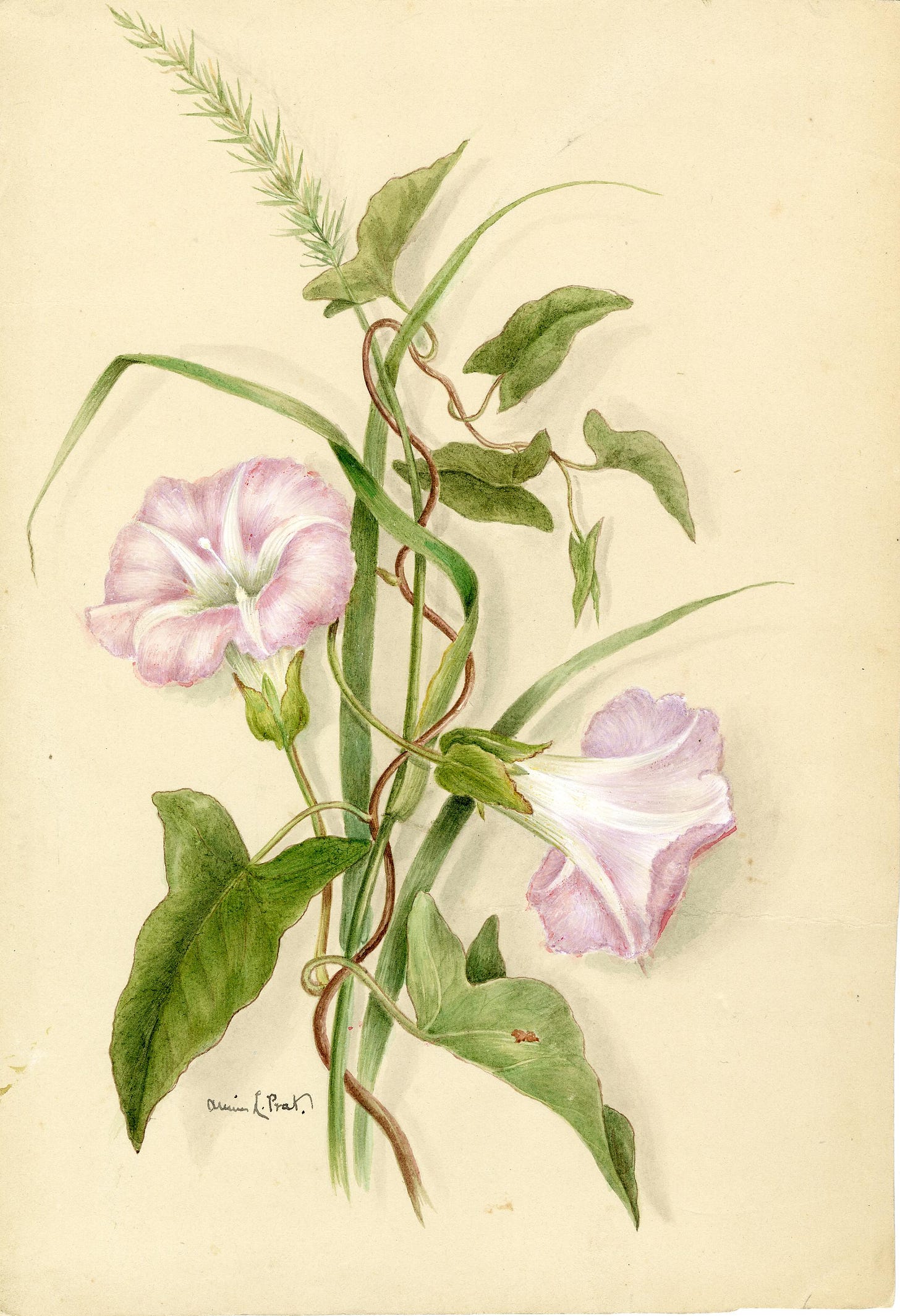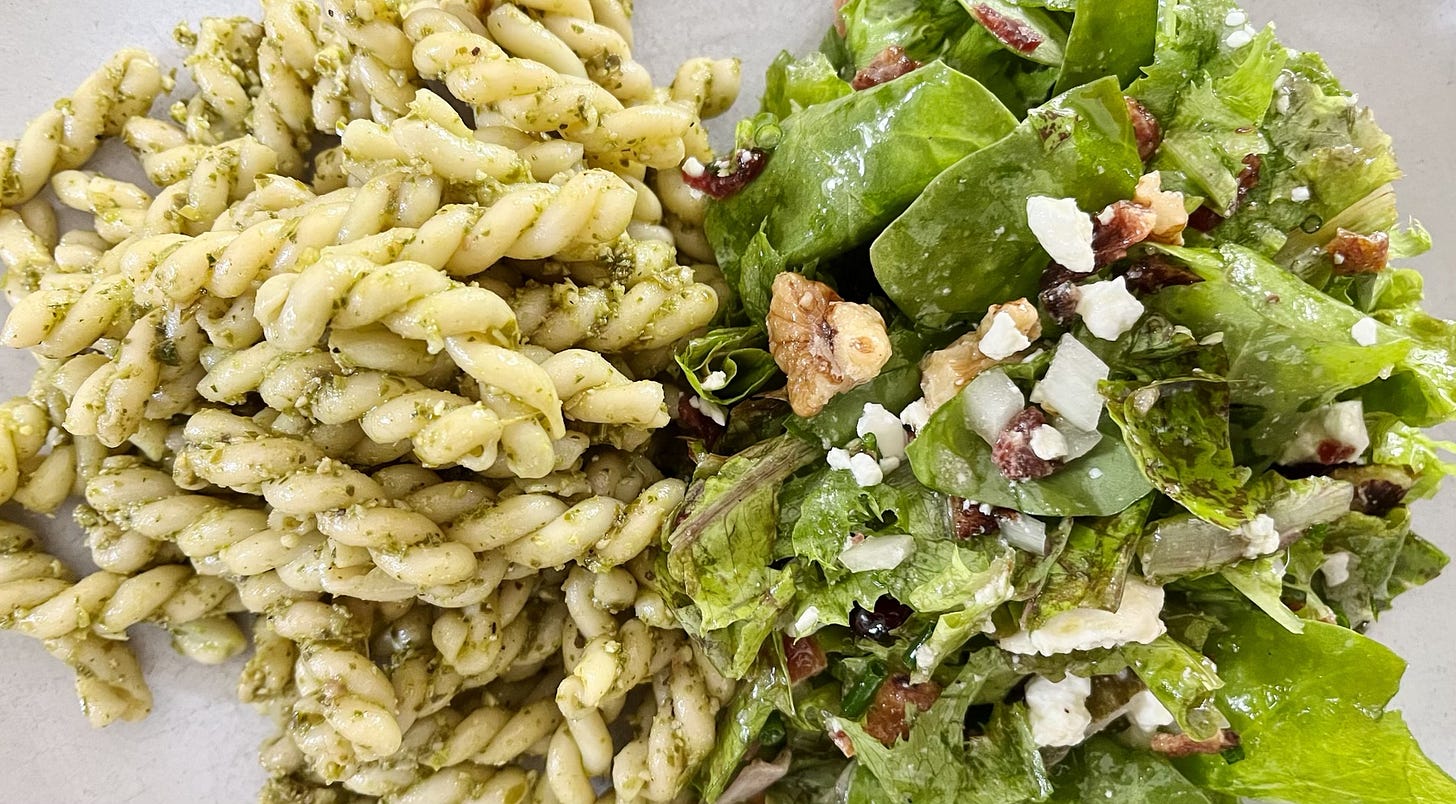The Parable of the Bindweed
Some fragmented thoughts on a tangled mess, acting against a weed vs. being for the flourishing of the garden, strawberries, and a favorite Tracy Chapman song
Friday, July 7
Grand Rapids, Mich.
I’ve spent long hours in the hot sun this week fighting weeds.
“Weed” is obviously an anthropocentric term, an epithet used to describe plants that grow where we don’t want them. In that context, the purslane and the dandelion are only sometimes weeds in my plots; I often leave them alone, they’re edible, and the story I tell myself is that I’m going to pick them for salads. Usually I let the clover grow too; the community garden’s soil isn’t rich, and I hope the clover will help improve it. The ragweed, which will torture those who suffer from seasonal allergies: unquestionably a weed. The field bindweed: Doesn’t the name tell you what you need to know? It’s my nemesis this season.
My community-garden plot is technically two half-plots. The half-plot to the east, shaded for much of the morning and therefore undesirable to many gardeners, is the space I’ve tended for three growing seasons now. The half-plot to the west is new to me. Last year, someone else grew tomatoes, sunflowers, and gladioli there; I might have seen her once, but I got to witness the beauty of her handiwork all season long.
When that gardener decided not to return this year, I was asked if I might like to have this half-plot too. Now, in all, I have a bit more than 600 square feet under my care. Within that space, there’s such variation: different levels of shade at different times of day, different textures to the soil, different bugs and pests and weeds and volunteers. And it’s in this new-to-me half-plot that I’ve become acquainted with the field bindweed, also known as devil’s guts.
Bare ground is the bindweed’s delight. A cousin of morning glory and a native of Eurasia, it’s believed to have arrived in the U.S. centuries ago, its seeds having infiltrated a packet of seeds brought by a settler. Now it’s everywhere. It takes eager advantage of open space and thrives even in relatively poor soil, quickly forming a densely woven carpet of vine and leaf. Mulching can help. Last year, I was pretty disciplined about spreading wood chips. But this year, I surrendered to the pre-weariness I felt at the mere thought of carting wheelbarrow after wheelbarrow of mulch. Now I’m paying the penalty.

If the bindweed is annoying in visible ways, it’s even more pernicious in the places I can’t see. It produces and emits chemicals that inhibit the germination of other seeds in its vicinity. And it subdues what else manages to grow with the help of its extensive root structure, which greedily absorbs water and nutrients below the surface.
Every day when I go to the garden, I can see what the bindweed is capable of, how opportunistic it is, how relentless. It treats seedlings like scaffolding, as if they were placed for its convenience. It threatens to smother the yellow squash that my garden neighbor, Roger, started and shared; the beans that have come up surprisingly late this year; the potatoes, some of which are just beginning to flower; even the sunflowers, which are growing fast too and seem determined to rise above it all, as if they know that their thriving will create shade that deprives the bindweed of the sun it seeks.

I’ve tried to wish the bindweed away. I have spent days pretending that it’s just not there. I have read up on bindweed too, such that I am am now very well informed about its habits and its predilections, its adaptability and its resilience, its economic costs and how it has infested agricultural land all over the world. None of these strategies has done anything to the bindweed that keeps growing in the soil for which I am responsible. There is no substitute for getting my hands dirty, for pulling the bindweed out by its roots, for the patient work of weeding.
I’m not against the bindweed merely for the sake of being against the bindweed; I fight it because I want flourishing for my crops as well as for my neighbor’s and indeed for this soil. The distinction matters. The bindweed isn’t the only thing that threatens the flowers and the vegetables either; I’ve lost count of how many Colorado potato beetles and Mexican bean beetles I’ve squashed. Anyway, tending to flourishing requires more than just removal of threats. The plants need sunlight and water, nitrogen and phosphorus, pollinators and beneficial microbes, attention and care. Early in the season, I added some vermicompost to improve the soil. I’ve sought to install companion plants that might benefit my crops’ growth.
Most of the visible bindweed in my plot has been eradicated—for the moment. I can see it in abundance just over the line, in the neighboring plot. It has no respect for the artificial boundaries we draw in the soil. I also know I wasn’t able to get all of its deep roots, and its seeds—so many seeds!—last a very long time. Unless I stay vigilant, it will return. Unless I grow something better and tend it well, it will come back. Unless my neighbors, too, do their part, it will never go away.
What I’m Cooking: We’ve finally come to that time of year when the garden is offering enough abundance to find its way into most meals. For dinner the other night, I made pesto from our remaining garlic scapes as well as basil from the yard. Twice this week, we had leftovers for lunch with salad. I hate salad, but I know it’s good for me. Our lettuce is thriving, and there’s something magical about harvesting vegetables just a few minutes before a meal. Also, I added bacon and cheese.
Wimbledon is on—it’s one of the main sportsball events that I care about—and it’s still strawberry season, but just barely, according to the farmer from whom I buy berries. “We’re day to day now,” she told me on Wednesday. So I bought a flat of strawberries. We’ll have strawberries and cream while we watch the tennis. I’ll freeze some berries for the colder months. I’ve already made one batch of strawberry-rhubarb jam. I’m thinking I’ll do some strawberry and balsamic vinegar jam, too, and perhaps strawberry and black pepper. Any other suggestions?
What I’m Listening to: Many, many summers ago, I went to a music festival with some friends. I grew up with an odd and limited range of music. As a Suzuki kid, those tapes (yes, tapes) were playing every morning in our kitchen, and I can still hear Handel’s Chorus from Judas Maccabaeus, the Bach Double, and of course Twinkle, Twinkle, Little Star in my head and do the fingerings. Then there were the records (yes, records) that my parents would sometimes put on, mainly Carole King, the Carpenters, and every once in a while, Petula Clark. So there I was at this music festival, which was called Lilith Fair, and I had absolutely no idea what was going on. Why were there so, so many women? Was that marijuana I smelled everywhere? Who was this phenomenal singer with that gorgeous, velvety voice?
Her name was Tracy Chapman, and I was entranced.
When my friend Kenji was visiting a couple of weeks, we started talking about music, and a Tracy Chapman song sprang from my memories. I hadn’t heard “The Promise” in ages, but we put it on, and immediately I found myself back in the ache and the longing of my late teens, which, to be honest, isn’t all that different from the ache and the longing of my twenties or the ache and the longing of my thirties. That voice! That guitar! Those strings! To my mind, “The Promise,” from her 1995 album New Beginning is one of the greatest, most tender love songs. I don’t think, though, it must be for a lover in the conventional sense. Suffused with sorrow but also redolent with hope, it could be sung to a parent or a dear relative who has passed, to a long-lost friend, or, at risk of falling into the “Jesus is my boyfriend” trap, even to God or to the church.
There’s something special about revisiting an old favorite—a song that meant something to you in an earlier time, a piece that stirs memories—preferably fond ones, but I have plenty of room for complicated ones too. Do you have a song that does this for you? I’d love to know and add a few things to my playlist.
That’s all I’ve got this week. With the holiday on Tuesday, I’ve been all discombobulated and I almost forgot yesterday was Thursday. I’m so glad we can stumble through all this together, whatever day it is, and I’ll try to write again soon.
All my best,
Jeff




I needed some space to gently cry this morning for the loss of my beloved husband six year's ago. Tracy's song let me do that. Thank you.
"Anyway, tending to flourishing requires more than just removal of threats." Jeff, these words will stick with me today. So much energy can go into battling against forces that seem to overwhelm goodness. Today I am going to focus on the goodness around me, the flourishing that is happening in my little family. Thank you for starting my day off so well with your beautiful and thoughtful prose. I will definitely be out tending my garden today!